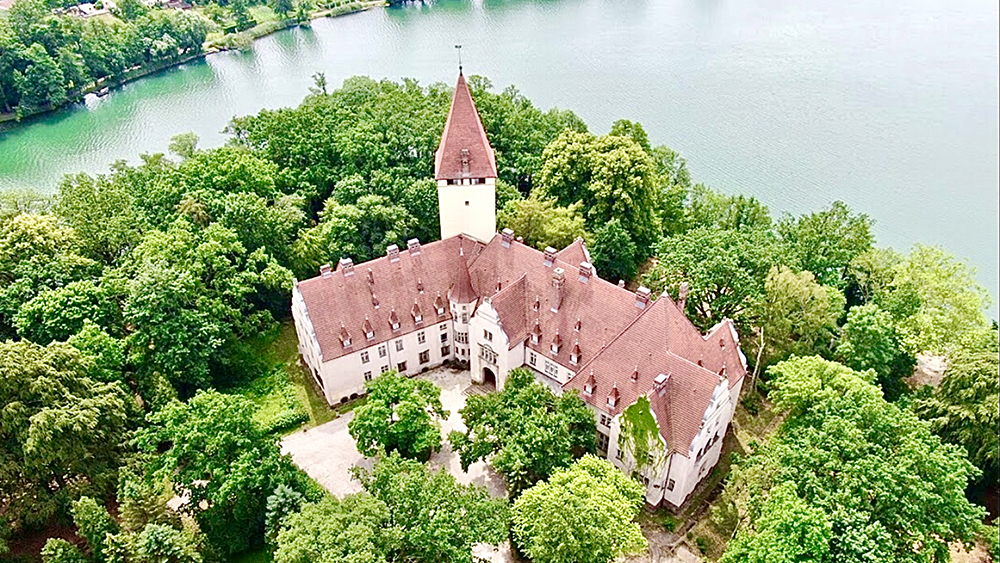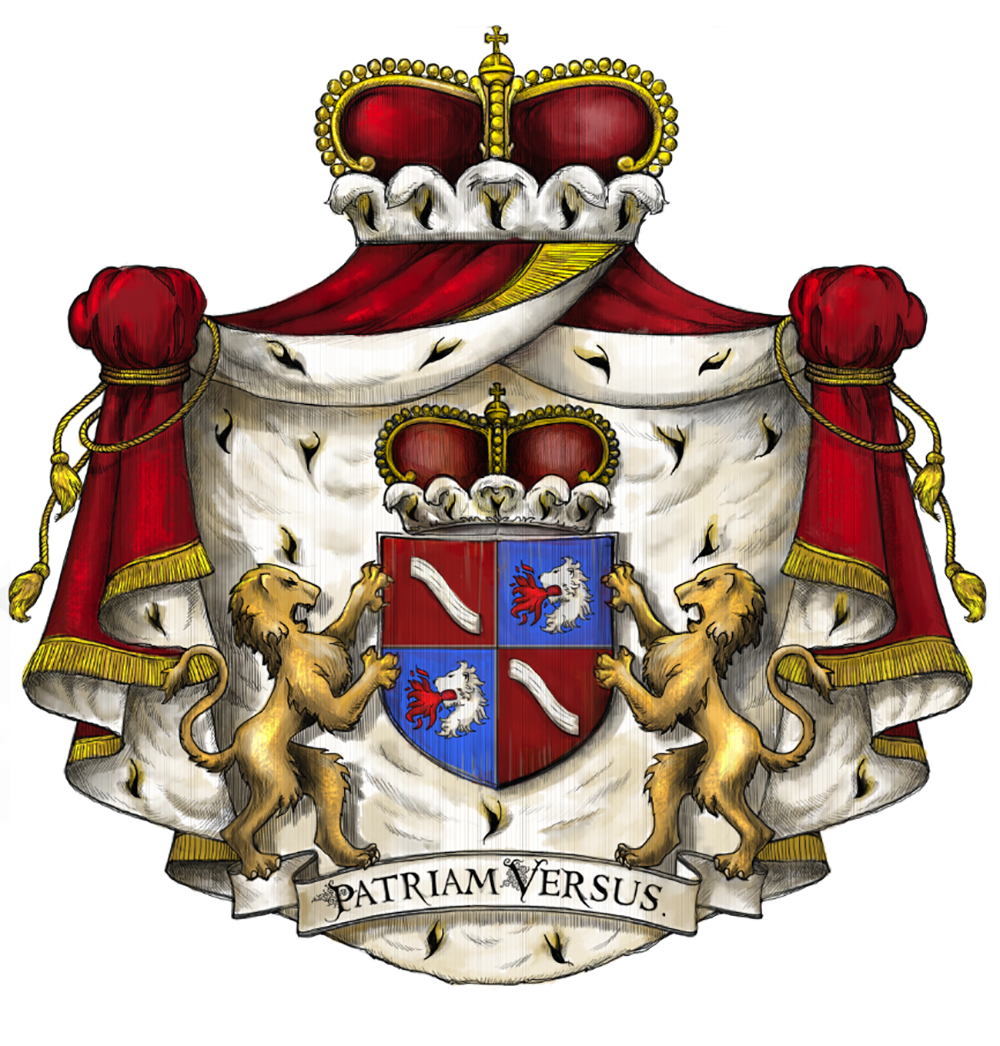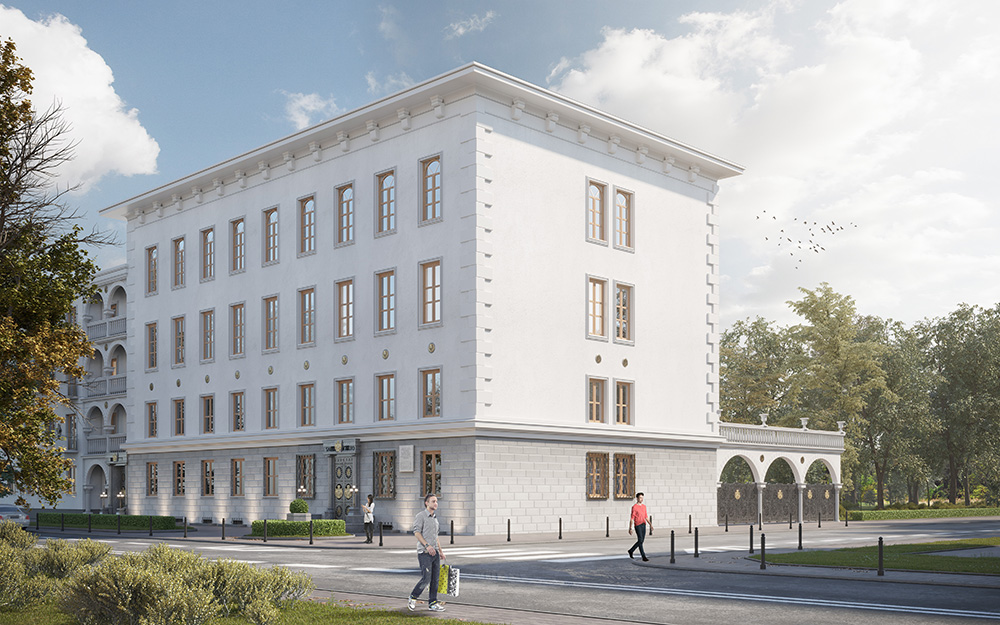Exclusive interview with
His Seréne Highness Prince Jan Lubomirski-Lanckoroński
You studied law in your homeland, as well as abroad. Later, you worked in the City of London for various firms. Besides Polish, you’re fluent in German, English, Italian, French and Russian. These are all ingredients for a superb international career as a top manager. However, you decided to go back to Poland where you were born. Why?
Looking at the history of my ancestors, I am not an exception regarding international education. By the time of Sebastian Lubomirski, the family had already attached great importance to education. It wasn’t unusual for successive members of the Lubomirski family to send their offspring on journeys across Europe so that they could acquire knowledge, experience and skills. However, in each case, after gathering all the desired skills, the Lubomirski would return to their homeland to make the best use of their abilities and contribute to the country. It was no different with myself. I greatly appreciate the fact that I had the opportunity to travel the world, meet many inspiring people, and gain knowledge and experience. However, just like my ancestors, I cannot imagine staying outside the borders of my homeland. I have my roots in Poland and this is the place from which we descended, with which I fully identify and where I build our future.
You come from one of the most prominent aristocratic families of Poland. In your opinion, how relevant are the nobility in the 21st century?
The Lubomirski family has always had the common good at heart. They specialised in almost every field, from the art of war through politics and diplomacy, entrepreneurship to science and culture in the broadest sense. They left behind countless possessions that are now part of the national heritage. I believe the Lubomirski legacy is one of the greatest, if not the greatest, among Polish aristocratic families. Looking at it from today’s perspective, our family has been a kind of carrier of history and tradition. It is through its art collections or numerous foundations that we’ve shaped the culture of our homeland. The family legacy builds the national legacy. One example is the Ossolineum, which was created by Maksymilian Ossoliński and Henryk Lubomirski, and thanks to the donated collections (including those of my great-grandfather Stefan Lubomirski) and the financial support of our family, it functions to this day as the Ossoliński National Institute with the most valuable works of Polish literature and beyond. The Wilanów Museum and Łazienki Królewskie Park, which are visited by thousands of tourists every year, also have collections that belonged to the Lubomirski family. Tradition and history not only shape a nation, but above all, enable it to survive the most difficult times, as the years of occupation of our country have perfectly shown. This was precisely one of the main goals of the invaders: to eliminate the aristocracy and the elites, as they were known to be the guarantors of the continuation and potential for rebirth of the Polish national identity. Along with Prince Regent Zdzisław Lubomirski – one of the fathers of Polish independence –Marshal Józef Piłsudski said, ‘A nation that loses its memory ceases to be a nation – it becomes merely a collection of people, temporarily occupying a given territory’. I also share this belief.

The Lubniewice Castle in Poland – one of the homes of His Seréne Highness
We can say that your family owned lots of beautiful castles and palaces before World War II. What happened to all of them and your family’s large fortune?
It’s true. The Lubomirski family had worked for its status, fortune and estates for years. A lot of land was given to us as a reward for our work for the motherland. This continued until the 20th century. Unfortunately, the war didn’t spare anyone and many of our castles and palaces were destroyed or taken over by the invaders. Nevertheless, I think that the agrarian reform of 1944 was the worst disaster for us. The communists, as I said earlier, set for themselves the goal of eradicating the aristocracy and landed gentry. The authorities then took everything from us, without any reparations. In a nutshell, the state simply robbed us. What’s more, the former owners were banned from approaching the estates seized by the authorities, and were not allowed to live in the district where the former estate was located. If my father, Prince Stanisław Lubomirski, had been caught walking around his parents’ castle in Kruszyna, he would have faced severe imprisonment. After the long years of communism, the sought-after freedom and change of power came in 1989. It might seem that at this point, we should have recovered everything that was taken away. Well, it’s not as simple as it seems. My father fought a long battle for the property to be returned to its owners. It’s interesting to note that he managed to recover those properties that were taken from us in violation of the communist laws that were in force at the time, whereas other cases are still pending till today. As you can see, the issue of reprivatisation, which would seem to be something obvious, still hasn’t been resolved in Poland, despite the fact that this has been done in all the other European countries, such as Hungary, for example.
Your family has been a well-known patron of the arts. Even today, you own paintings attributed to Leonardo da Vinci, Pablo Picasso and from Marie Antoinette’s personal painter, Elisabeth Louise Vigée-Le Brun, too. You’ve been lending pieces of the Warsaw-based Princes Lubomirski Collection to various museums. One of these examples is your involvement in the Princes Czartoryski Museum in Krakow, where visitors can see over 100,000 art pieces from world-famous masters, including the world-renowned Lady with an Ermin by Leonardo da Vinci.
Following up on what I said earlier, a family legacy builds the national legacy. I’m very happy when I can share the works of art collected by me and my family for hundreds of years with a wider audience. Recently, I had the pleasure of lending the painting Madonna and Child with Lamb attributed to Leonardo da Vinci to the Museum of King Jan III’s Palace in Wilanów, which will be shown at the exhibition ‘Leonardiana in Polish Collections’. I also have very fond memories of our collaboration with the National Museum in Krakow, where we’ve deposited Saxon stained-glass windows from around the year 1200. Also, I’m proud of the fact that I was invited to join the council of the Museum Łazienki Park in Warsaw and the Museum in Wilanów, both of which were founded by my family. It’s a kind of confirmation that Polish aristocracy still plays an important role in the life of the country. Speaking of the Czartoryski, with Maciej Radziwiłł, we managed the Princes Czartoryski Foundation belonging to my uncle, Prince Adam Czartoryski, and in accordance with his and his ancestors’ will, the collection of the Princes Czartoryski was handed over to the Polish nation for 5% of its value. The aim was, of course, for the precious works to remain in the country. A very important person who absolutely must be mentioned here is Aunt Karla Lanckorońska, who donated two paintings by Rembrandt van Rijn–Girl in a Picture Frame and A Scholar at His Writing Table–to the Royal Castle Museum in Warsaw, as well as works of art from the collection of the last king of Poland, Stanisław August Poniatowski. In turn, artwork of the early Italian Renaissance and Gothic period from the years 1300-1400 were donated to the Wawel Castle.

The coat of arms of the family
You run a charity organization, too. What does the Princes Lubomirski Foundation do for Poland and the Poles?
The Princes Lubomirski Foundation was established as an outcome and extension of my family’s philanthropic activities, pursued for many centuries. Our main objective is to care for people in need and to preserve our national heritage. The Foundation carries out educational, social and scientific activities, supporting specialised institutions and private individuals, as well as establishing its own facilities. Our programme activities are implemented through the co-financing of scientific and research projects, scholarships and cultural activities. The Foundation works to enable and facilitate learning for young people, supporting those in need, mainly through comprehensive activities involving the purchase of equipment for schools, preschools, medical and scientific institutions. We’re involved in the renovation and revitalisation of historic buildings, with particular emphasis on those associated with the Lubomirski family.
Basically, you’re a businessman – an entrepreneur active in various industries and market segments. You invest in real estate projects through the Landeskrone Group. But you’re also active in some non-business projects. The Princes Lubomirski Foundation produced The Crown game, which is a computer game based on 17th – 18th century Polish history. What was your reason for investing in this particular project?
I came up with the idea of creating the game called The Crown – Korona Rzeczpospolitej about 10 years ago, but at that time, there were no technical means to fully execute my concept. I wanted the game to be universal and playable on any device, anywhere. That’s why I decided to make The Crown free of charge in order to reach as many people as possible. The main reason for creating the game was the desire to bring back the times of greatness of the Polish-Lithuanian Commonwealth. Our country was a power in Europe then, but what’s very important is that we had a high degree of tolerance resulting from the fact that the Commonwealth was a cultural melting pot, bringing the presence of various nations together. We tried to emphasise this aspect in the game by giving the players the possibility to choose various characters (the Lithuanian, the Cossack, the Noblewoman, Koroniarz [an inhabitant of the Crown of the Kingdom of Poland]), as well as several language versions. (At the moment, the game has been translated into Ukrainian and English, and there are plans to translate it into Turkish, Lithuanian and Hungarian, among other languages.) The educational qualities of the game were obvious to me from the very beginning. The Crown‘s premiere was planned for 2020, but due to the pandemic and the closure of schools in our country, we decided to have the game available in March, so that young people could acquire and reinforce their knowledge in an enjoyable manner.

Interiors of Lubniewice Castle – home of the princely family
Another extremely important endeavour for me was the development of a family publication. The Lubomirski Polish Princes trilogy is the result of painstaking work by many people. The inspiration for this publication came from many conversations with my parents, Stanislaw and Ewa, about the history of the family. I was taught patriotic values, and the importance of identity and awareness of one’s roots from an early age. Hence my desire to share my family’s experiences, many anecdotes, interesting facts and previously unpublished photographs of key events in Polish history with a wider audience. The trilogy was written largely thanks to the incredible genealogical work done during the dark days of communism by my grandfather’s sister, Aunt Leonia Lubomirska. She collected an extraordinary amount of historical material on the family. The family archive was a solid foundation for the creation of this monumental collection, but the work of the whole Lubomirski Princes Foundation team, and the cooperation of historians and museums also contributed to the final result. All proceeds from the sale of the books or premium in-game add-ons will, of course, go towards the Foundation’s statutory purposes.
You’re also a real estate developer in Poland. Your focus is on luxury properties and it seems that you have a particular fondness for the Art Deco style.
It’s true that for several years, I’ve been developing the Landeskrone Group, which includes several real estate companies. Indeed, the Art Deco style is one of my favourites, and this is due to the fact that Warsaw at that time was flourishing, and many beautiful gems can be found among the buildings of our capital city. I invest in the largest Polish cities, mainly in residential buildings, office buildings and in the hotel market at their centres. The prime investments by the Landeskrone Group in Warsaw include the Palazzo Murano, which is created in the style of an Italian Renaissance palazzo and houses mostly office space. Another investment is the Maison de Luxe building – in Art Deco style – in the city centre, which is also an office building, and other properties in the capital, Łódź, Kraków, etc. In the very centre of Kraków, 100 m from the main square, in the Lubomirski Palace, we’re planning one of the largest hotel investments, which is currently in the design phase and is projected for the coming years.
The Polish economy has been rising for years. Many Polish brands have become regional heavyweights. Warsaw looks like an American metropolis as well, with its skyscraper buildings. What’s your prediction? How will it change due to the pandemic?
This is a difficult question and one that probably has the world’s brightest minds thinking about it. Nevertheless, the real estate market in Poland, despite the 2020 pandemic, developed very dynamically–there was an over 7% growth in the real estate developers’ market. Also, we do not detect any major outflow of tenants in the office lease market. This is a very good omen for 2021. Therefore, I assume that we can expect an economic upturn in the coming years in the world, as well as in Poland. The main reason for this situation will undoubtedly be the global vaccination campaign, which will hopefully solve the problem of the pandemic. However, it’s already clear that Poland and Hungary are at the forefront of economic growth among European countries. This is undoubtedly due, first and foremost, to the good, central European location of our countries, the private companies active on the market, and also the aid interventions of our governments.

The Palazzo Murano in Warsaw is one the projects of His Seréne Highness’ company Landeskrone Group
You’re really active on Instagram with over 80K followers. You travel a lot, you take care of your connections with other noble or royal houses. Why is it important to be transparent as a modern aristocrat?
Modern times are saturated with social media, and in order to promote positive attitudes, activities and trends, it’s necessary – and even essential – to use them. It’s important for me to be active in all social and philanthropic areas, but also to promote this lifestyle among other people who have such means, and encourage them to become active in supporting local communities and charities. Our contact with the ruling families and other aristocratic families of the world is largely due to the fact that we’re all related. Our family is related to the current Spanish Bourbon dynasty, as well as many other European families such as the Habsburgs, the Wittelsbachs, but also to aristocratic families of Russia, France and so on. History has shown Lubomirski family connections to the ruling Hungarian families in the past many times as well. Our family personally owes a lot to the Hungarian king on the Polish throne, Stefan Batory – considered to be one of the best monarchs in the history of our country. My tenth-great-grandfather, Sebastian Lubomirski, was in constant contact with King Stefan, participating in his political endeavours and military expeditions. My family’s contact with Hungary was very frequent and also connected by marriages. For example, one of my ancestors married Barbara Hrussoy de Zablath. In the subsequent centuries, the family of the Lubomirski princes supported the pro-independence efforts of the famous Francis II Rákóczi. Two members of my family were even candidates for the throne of the Kingdom of Hungary. We also owned vineyards in the famous Tokaj area.
I have a long-standing relationship with the British ruling family and a joint venture: ‘Chance for Monuments’ conference, under the patronage of Prince Charles. It concerned the activities which we could undertake in order to protect historical monuments in Europe. Prince Charles is also very much involved in environmental issues. Our guest of honour at the conference was Hank Dittmar, director general of the Prince Charles Foundation.

Prince Jan Lubomirski-Lanckoroński and his wife, Princess Helena
Could you tell us a little bit more about your personal life? We know that you live in one of your family’s castles in Lubniewice with your wife, Princess Helena; that you’re a father of three. Is there anything else you would care to share with our readers?
We live in several places, not only Lubniewice Castle. We generally move between four places: London, Warsaw, Szczawnica and my wife Helena’s native Paris. This is due to our business activities primarily, but also to family relations. Additionally, Warsaw is the headquarters of the Princes Lubomirski Foundation which I established. Every year, we’re very active in the field of education, e.g. funding scholarships for schoolchildren, environmental protection, medicine, and the protection and restoration of historical monuments. The Szczawnica Health Resort, in turn – apart from being an unusual place on the map of Poland – is actually a private town owned by my wife. Along with her brother, she’s in charge of Szczawnica Spa, which includes the biggest private theatre in Poland, a museum, the main square of the town, restaurants, hotels, spa parks, many houses and the whole roadway infrastructure. It’s a rarity in our country as it is entirely private – in the hands of my wife’s family. In the old days, the spa was owned by the Hungarian Szalay family. Insofar as London, my children go to school there, so we spend a lot of time in this city. And when my wife longs for the city of her ancestors, we travel to Paris.
Photos: Courtesy of Prince Jan Lubomirski-Lanckoroński
the 2nd of February, 2021






